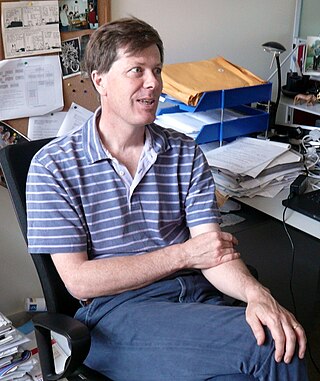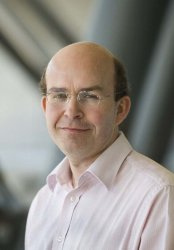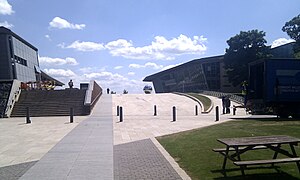
Sir John Edward Sulston was a British biologist and academic who won the Nobel Prize in Physiology or Medicine for his work on the cell lineage and genome of the worm Caenorhabditis elegans in 2002 with his colleagues Sydney Brenner and Robert Horvitz at the MRC Laboratory of Molecular Biology. He was a leader in human genome research and Chair of the Institute for Science, Ethics and Innovation at the University of Manchester. Sulston was in favour of science in the public interest, such as free public access of scientific information and against the patenting of genes and the privatisation of genetic technologies.

The Human Genome Project (HGP) was an international scientific research project with the goal of determining the base pairs that make up human DNA, and of identifying, mapping and sequencing all of the genes of the human genome from both a physical and a functional standpoint. It started in 1990 and was completed in 2003. It remains the world's largest collaborative biological project. Planning for the project started after it was adopted in 1984 by the US government, and it officially launched in 1990. It was declared complete on April 14, 2003, and included about 92% of the genome. Level "complete genome" was achieved in May 2021, with a remaining only 0.3% bases covered by potential issues. The final gapless assembly was finished in January 2022.
The Cancer Genome Project is part of the cancer, aging, and somatic mutation research based at the Wellcome Trust Sanger Institute in the United Kingdom. It aims to identify sequence variants/mutations critical in the development of human cancers. Like The Cancer Genome Atlas project within the United States, the Cancer Genome Project represents an effort in the War on Cancer to improve cancer diagnosis, treatment, and prevention through a better understanding of the molecular basis of the disease. The Cancer Genome Project was launched by Michael Stratton in 2000, and Peter Campbell is now the group leader of the project. The project works to combine knowledge of the human genome sequence with high throughput mutation detection techniques.

Ubiquitin-associated protein 1 is a protein that in humans is encoded by the UBAP1 gene.

Interferon-induced transmembrane protein 3 (IFITM3) is a protein that in humans is encoded by the IFITM3 gene. It plays a critical role in the immune system's defense against Swine Flu, where heightened levels of IFITM3 keep viral levels low, and the removal of IFITM3 allows the virus to multiply unchecked. This observation has been further advanced by a recent study from Paul Kellam's lab that shows that a single nucleotide polymorphism in the human IFITM3 gene purported to increase influenza susceptibility is overrepresented in people hospitalised with pandemic H1N1. The prevalence of this mutation is thought to be approximately 1/400 in European populations.

Rho-related BTB domain-containing protein 3 is a protein that in humans is encoded by the RHOBTB3 gene.

Pseudouridylate synthase 7 homolog-like protein is an enzyme that in humans is encoded by the PUS7L gene.
The Vertebrate Genome Annotation (VEGA) database is a biological database dedicated to assisting researchers in locating specific areas of the genome and annotating genes or regions of vertebrate genomes. The VEGA browser is based on Ensembl web code and infrastructure and provides a public curation of known vertebrate genes for the scientific community. The VEGA website is updated frequently to maintain the most current information about vertebrate genomes and attempts to present consistently high-quality annotation of all its published vertebrate genomes or genome regions. VEGA was developed by the Wellcome Trust Sanger Institute and is in close association with other annotation databases, such as ZFIN, the Havana Group and GenBank. Manual annotation is currently more accurate at identifying splice variants, pseudogenes, polyadenylation features, non-coding regions and complex gene arrangements than automated methods.

Richard Michael Durbin is a British computational biologist and Al-Kindi Professor of Genetics at the University of Cambridge. He also serves as an associate faculty member at the Wellcome Sanger Institute where he was previously a senior group leader.
Cancer genome sequencing is the whole genome sequencing of a single, homogeneous or heterogeneous group of cancer cells. It is a biochemical laboratory method for the characterization and identification of the DNA or RNA sequences of cancer cell(s).
Richard Mott is Weldon Professor of Computational and Statistical Genetics in the research department of Genetics, Evolution and Environment at University College London. He was previously at the Wellcome Centre for Human Genetics and a Professor by Research at Oxford University.
Sir Michael Rudolf Stratton, is a British clinical scientist and the third director of the Wellcome Trust Sanger Institute. He currently heads the Cancer Genome Project and is a leader of the International Cancer Genome Consortium.
COSMIC is an online database of somatically acquired mutations found in human cancer. Somatic mutations are those that occur in non-germline cells that are not inherited by children. COSMIC, an acronym of Catalogue Of Somatic Mutations In Cancer, curates data from papers in the scientific literature and large scale experimental screens from the Cancer Genome Project at the Sanger Institute. The database is freely available to academic researchers and commercially licensed to others.

NOP2/Sun domain family, member 2 is a protein that in humans is encoded by the NSUN2 gene. Alternatively spliced transcript variants encoding different isoforms have been noted for the gene.

Robert Hugh "Bob" Waterston, is an American biologist. He is best known for his work on the Human Genome Project, for which he was a pioneer along with John Sulston.

The European Nucleotide Archive (ENA) is a repository providing free and unrestricted access to annotated DNA and RNA sequences. It also stores complementary information such as experimental procedures, details of sequence assembly and other metadata related to sequencing projects. The archive is composed of three main databases: the Sequence Read Archive, the Trace Archive and the EMBL Nucleotide Sequence Database. The ENA is produced and maintained by the European Bioinformatics Institute and is a member of the International Nucleotide Sequence Database Collaboration (INSDC) along with the DNA Data Bank of Japan and GenBank.

Timothy John Phillip Hubbard is a Professor of Bioinformatics at King's College London, Head of Genome Analysis at Genomics England and Honorary Faculty at the Wellcome Trust Sanger Institute in Cambridge, UK. Starting March 1, 2024, Tim will become the director of Europe's Life Science Data Infrastructure ELIXIR.

Alexander George Bateman is a computational biologist and Head of Protein Sequence Resources at the European Bioinformatics Institute (EBI), part of the European Molecular Biology Laboratory (EMBL) in Cambridge, UK. He has led the development of the Pfam biological database and introduced the Rfam database of RNA families. He has also been involved in the use of Wikipedia for community-based annotation of biological databases.
Donna R. Maglott is a staff scientist at the National Center for Biotechnology Information known for her research on large-scale genomics projects, including the mouse genome and development of databases required for genomics research.

















